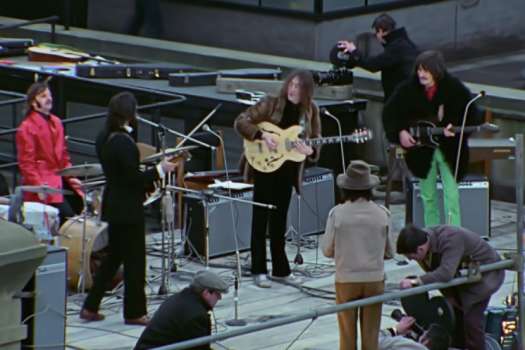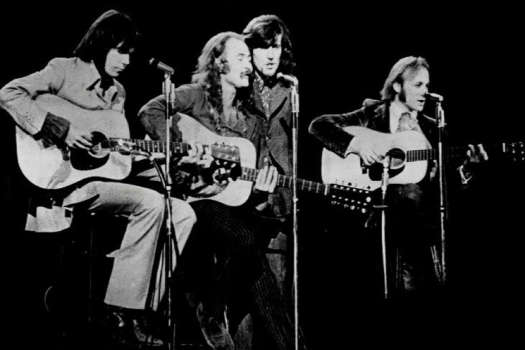Although known by various other terms of endearment (y'alternative, Americana), the essence of alt-country is in preserving the North American song in its traditional form while consistently modernising its sound. Yet, as the genre has theoretically expanded to include a large chunk of the music recorded throughout the 20th century (e.g. Elvis Presley, Sun Sessions; Ray Charles, Modern Sounds In Country & Western Music; Rolling Stones, Exile On Main Street), the term is now commonly applied to any artist with predominantly traditional influences who chooses to steer clear of the rules laid down in Nashville or the music biz overall.
Outlaw Country
Taking a hint from the young country-rock kids, many established songwriters began leaving the Nashville grind, growing their hair, and smoking pot. Surprisingly, many of them subsequently found the wider audiences that had always eluded them. The Outlaw movement was largely based in Texas, which proved a much more conducive atmosphere for producing gifted songwriters, and where a healthy anti-Nashville spirit thrives to this day.
Classics: Willie Nelson, Willie & Family Live (Columbia, 1978); Waylon Jennings, Honky Tonk Heroes (RCA, 1973); Townes Van Zandt, Our Mother The Mountain (Tomato, 1969)
Contemporary: Richard Buckner, Devotion + Doubt (MCA, 1997); Neko Case, The Virginian (Bloodshot, 1997); Hank Williams III, Risin' Outlaw (Curb, 1999)
Country-Rock
If rock and roll itself was a collision of black and white musics, country-rock attempted to combine them in much purer ways, owing to the drive toward racial unity and left/right political harmony in the late 60s. While Gram Parsons is rightly acknowledged to be the patron saint of the movement, taking the Bakersfield sound of Merle Haggard and Buck Owens and mixing in Memphis soul, many in the L.A. scene that Parsons gravitated to were finding their own similar formulas. The excitement of this music amid the excesses of psychedelia would go on to dominate the American rock aesthetic by varying degrees (the Band, Grateful Dead, CCR) until the mid-'70s when the Eagles decisively corporatised it.
Classics: The Byrds, Sweetheart Of The Rodeo (Sony, 1968); Flying Burrito Brothers, Hot Burritos, An Anthology (A&M, 2000); Great Speckled Bird (Stony Plain, 1970)
Contemporary: Steve Earle, Guitar Town (MCA, 1986); Dwight Yoakam, Guitars, Cadillacs, Etc. (Warner, 1986); BR5-49 (Arista, 1996)

Jason and the Scorchers
Cow-Punk
If punk's purpose was to reclaim the original fire of rock'n'roll, it was inevitable that American punks would go a step further and add a few classic drinkin' and fightin' songs to their repertoires as a tribute to their rebellious forefathers. Although originally considered a novelty, the best cow-punk bands would ultimately give country the same adrenaline shot that the Sex Pistols gave to rock.
Classics: Rank & File, Sundown (Rough Trade, 1982); Jason & The Scorchers, Fervor (Mammoth, 1983); Handsome Ned, The Name Is Ned (EMI, 2000)
Contemporary: Alejandro Escovedo, Bourbonitis Blues (Bloodshot, 1999); Old 97s, Too Far To Care (Elektra, 1997); The Sadies, Precious Moments (Bloodshot, 1998)

Whiskeytown
No Depression
Basically a consolidation between country-rock and cow-punk with a lot of Neil Young thrown in, No Depression became the rallying point for a new generation eager to embrace traditional American music. At the vanguard was Uncle Tupelo, the band that would ultimately splinter into Wilco and Son Volt, and inspire countless imitators through their relentless touring and devotion to the music. Of course, others were there too, including many often overlooked Canadian bands such as Jr. Gone Wild.
Classics: Uncle Tupelo, Anodyne (Sire, 1993); The Jayhawks, Hollywood Town Hall (American, 1992); Blue Rodeo, Outskirts (WEA, 1987)
Contemporary: Whiskeytown, Stranger's Almanac (Outpost, 1997); Lucinda Williams, Car Wheels On A Gravel Road (Mercury, 1998); Nadine, Downtown, Saturday (Undertow, 1999)
Outlaw Country
Taking a hint from the young country-rock kids, many established songwriters began leaving the Nashville grind, growing their hair, and smoking pot. Surprisingly, many of them subsequently found the wider audiences that had always eluded them. The Outlaw movement was largely based in Texas, which proved a much more conducive atmosphere for producing gifted songwriters, and where a healthy anti-Nashville spirit thrives to this day.
Classics: Willie Nelson, Willie & Family Live (Columbia, 1978); Waylon Jennings, Honky Tonk Heroes (RCA, 1973); Townes Van Zandt, Our Mother The Mountain (Tomato, 1969)
Contemporary: Richard Buckner, Devotion + Doubt (MCA, 1997); Neko Case, The Virginian (Bloodshot, 1997); Hank Williams III, Risin' Outlaw (Curb, 1999)
Country-Rock
If rock and roll itself was a collision of black and white musics, country-rock attempted to combine them in much purer ways, owing to the drive toward racial unity and left/right political harmony in the late 60s. While Gram Parsons is rightly acknowledged to be the patron saint of the movement, taking the Bakersfield sound of Merle Haggard and Buck Owens and mixing in Memphis soul, many in the L.A. scene that Parsons gravitated to were finding their own similar formulas. The excitement of this music amid the excesses of psychedelia would go on to dominate the American rock aesthetic by varying degrees (the Band, Grateful Dead, CCR) until the mid-'70s when the Eagles decisively corporatised it.
Classics: The Byrds, Sweetheart Of The Rodeo (Sony, 1968); Flying Burrito Brothers, Hot Burritos, An Anthology (A&M, 2000); Great Speckled Bird (Stony Plain, 1970)
Contemporary: Steve Earle, Guitar Town (MCA, 1986); Dwight Yoakam, Guitars, Cadillacs, Etc. (Warner, 1986); BR5-49 (Arista, 1996)

Jason and the Scorchers
Cow-Punk
If punk's purpose was to reclaim the original fire of rock'n'roll, it was inevitable that American punks would go a step further and add a few classic drinkin' and fightin' songs to their repertoires as a tribute to their rebellious forefathers. Although originally considered a novelty, the best cow-punk bands would ultimately give country the same adrenaline shot that the Sex Pistols gave to rock.
Classics: Rank & File, Sundown (Rough Trade, 1982); Jason & The Scorchers, Fervor (Mammoth, 1983); Handsome Ned, The Name Is Ned (EMI, 2000)
Contemporary: Alejandro Escovedo, Bourbonitis Blues (Bloodshot, 1999); Old 97s, Too Far To Care (Elektra, 1997); The Sadies, Precious Moments (Bloodshot, 1998)

Whiskeytown
No Depression
Basically a consolidation between country-rock and cow-punk with a lot of Neil Young thrown in, No Depression became the rallying point for a new generation eager to embrace traditional American music. At the vanguard was Uncle Tupelo, the band that would ultimately splinter into Wilco and Son Volt, and inspire countless imitators through their relentless touring and devotion to the music. Of course, others were there too, including many often overlooked Canadian bands such as Jr. Gone Wild.
Classics: Uncle Tupelo, Anodyne (Sire, 1993); The Jayhawks, Hollywood Town Hall (American, 1992); Blue Rodeo, Outskirts (WEA, 1987)
Contemporary: Whiskeytown, Stranger's Almanac (Outpost, 1997); Lucinda Williams, Car Wheels On A Gravel Road (Mercury, 1998); Nadine, Downtown, Saturday (Undertow, 1999)




